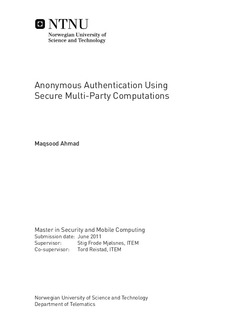Anonymous Authentication Using Secure Multi-Party Computations
Master thesis
Permanent lenke
http://hdl.handle.net/11250/262439Utgivelsesdato
2011Metadata
Vis full innførselSamlinger
Sammendrag
Typical authentication systems provide a method to allow registered users access to protected resources after the user successfully authenticates. A user successfully authenticates by proving his or her valid identity if he or she is a registered user. During a typical authentication process, the authentication server can directly or indirectly learn the actual identity of the user who authenticates. However, the user might not want any one to know the actual identity of the user, while still able to authenticate. This problem of user's anonymous authentication is the focus of this thesis project. This thesis project provides a solution for user's anonymous authentication using Secure Multi-party Computation (SMPC). In SMPC, the user information is distributed among the authentication servers, using a secret sharing scheme, in such a way that none of the authentication server individually possesses all the information of a user. However, these authentication servers can validate the user using some SMPC arithmetic operations. This thesis project provides a model for anonymous authentication and couples this anonymous authentication system with the Open Authentication Protocol (OAuth) to allow the user access to protected resources on the server. The model is explained using UML collaborations and SDL state transition diagrams. A analysis of the model is provided to ensure the security of the proposed system. A skeleton of the proposed model is provided which needs to be completed with appropriate code to realize the functionalities. This thesis project also provides an implementation of a simplified prototype which represents the core of the proposed model for anonymous authentication.
